
Our experts and industry insiders blog the latest news, studies and current events from inside the credit card industry. Our articles follow strict editorial guidelines.
There are legends in entrepreneurship of founders bootstrapping their businesses on personal credit cards and putting family finances at risk to follow their dreams.
The problem with those stories is that for every success there are undoubtedly many failures. Entangling personal and company finances creates complications that can trap people in financial dysfunction and even hinder the next great business idea.
Business credit cards keep company and personal expenses separate. Applying for business credit may require entrepreneurs to offer a personal guarantee of creditworthiness. But business cards make expense management and accounting more efficient, offer targeted perks such as flexible repayment plans, and help businesses build a credit score for future use.
The business credit landscape continually evolves as card companies compete for a share in entrepreneurship. Here are 51 intriguing business credit card statistics to describe today’s market and assess its prospects.
Business Credit Cards By the Numbers
1. A business credit card is a convenient expense and accounting tool, but only 29% of businesses seek business credit funding.1
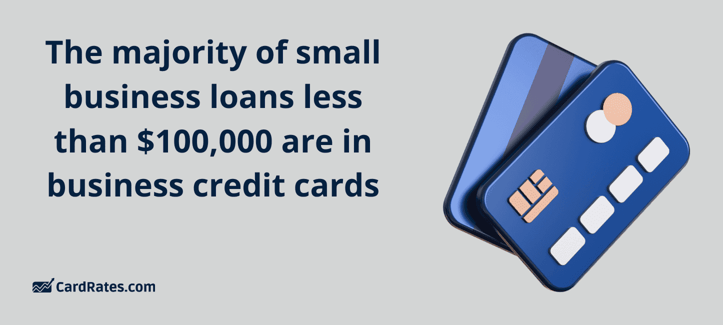
2. More than 46% of the $368 billion in outstanding small business loans in 2019 were in amounts less than $100,000. The majority of those loans were in business credit cards.2
3. JP Morgan Chase is the largest business credit card issuer, with about $73.2 billion in purchasing volume, according to 2017 data.3
4. Survey data ranked American Express highest in customer satisfaction with a score of 873 out of 1,000. Capital One ranked second (866), and PNC ranked third (858).4
5. Small businesses surveyed in 2023 said they had used a credit card as a primary or secondary funding source over the past 12 months. About 30% of small businesses said they used cards that way, while 22% said they relied on a loan or line of credit.5
6. The average limit for a business credit card is $56,100.6
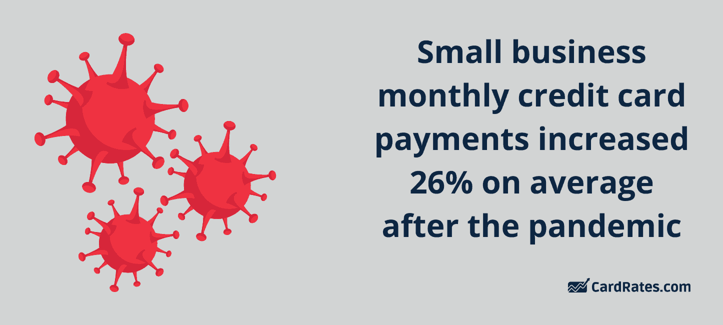
7. The COVID-19 pandemic has affected business credit card use. Small business monthly credit card payments, including interest charges, increased 26% on average after the pandemic.7
8. Personal credit cards are a factor for most business owners, with 61% reporting using personal credit cards for business expenses.8
9. The average APR on a new small-business credit card is 17.82%, slightly lower than the average for new consumer credit cards (19%).9
10. Businesses with annual revenue between $1 million and $5 million have average credit card balances 18% higher than in 2019.10
11. In a survey of 500 small to medium-sized firms earning between $150,000 and $10 million in annual revenue, 22% reported using business credit cards to meet financial contingencies in October 2023, up from 15% in July.11
12. Nearly three-quarters (73%) of small business owners surveyed in 2022 reported having a personal credit card. Most (61%) used that card to fund their business.12
13. The most common rewards category for small business credit cards is travel. Dining and gas purchases are the next most common.9
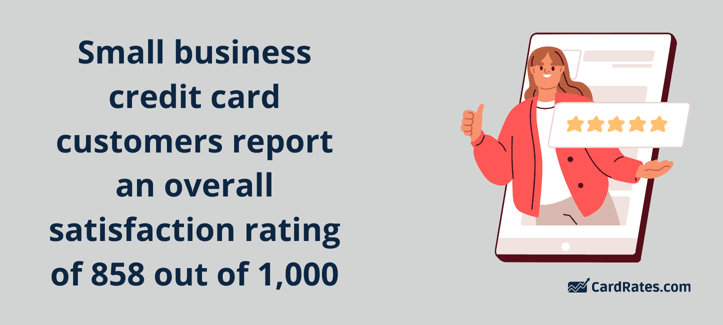
14. On a 1,000-point scale, small business credit card customers report an overall satisfaction rating of 858, according to 2023 data. That number is up seven points from 2022 and nine points from 2019.4
15. The median revolving balance for businesses that don’t pay off their credit card bill in full each month is $7,000.8
16. The most significant disadvantage to using a business credit card as a primary funding method was handling debt repayments, according to 48.5% of entrepreneurs.1
17. More than half (58%) of small businesses said they did not revolve a business credit card balance in any month in 2022. Only 17% carried a balance across all 12 months.2
18. Two-thirds (66%) of entrepreneurs surveyed said they prefer an alternative method to start their businesses instead of a credit card because of concerns about potential credit score damage.1
19. The typical credit line for a business card in 2022 was between $160,000 and $250,000. A total of 39.7% of entrepreneurs surveyed said they needed that amount of credit.1
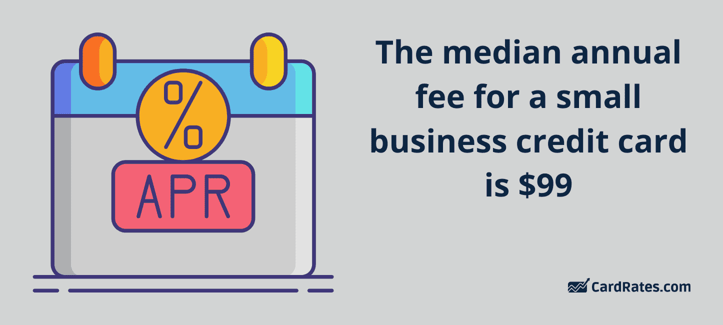
20. The median annual fee for a small business credit card is $99. Slightly less than half of small business cards carry an annual fee.9
21. Total monthly spending on small business credit cards is about 20% higher on average than before the COVID-19 pandemic.5
22. Despite the prevalent myth of entrepreneurs starting businesses on the backs of credit cards, less than one-third (29%) of businesses surveyed said they sought funding via business credit cards in 2022. Only 4.67% reported using a business credit card as a primary funding source at the startup stage.1
23. More than three-quarters (80%) of business owners report they do not have a business credit score or do not know it.12
24. Businesses are consistent transactors or revolvers. Those that pay their credit card balances consistently from month to month are likely (88%) to retain that behavior in the following year. Those that carry a monthly balance are also very likely (75%) to do the same in the following year.2
25. The most popular small business card expense category is office supplies, with 78% of firms reporting using that category.4
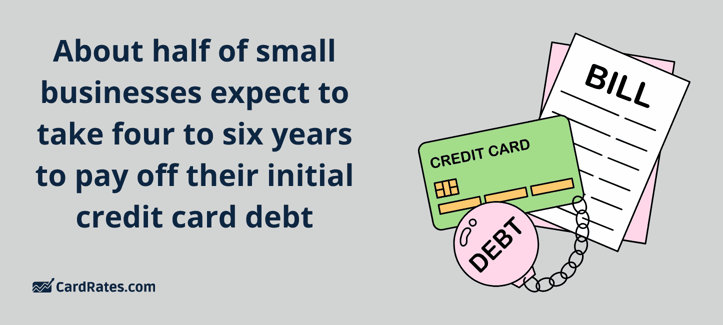
26. About one-half (49.2%) of 2023 survey respondents reported an expected need of four to six years to fully repay their initial debt after using a business credit card as their primary financing method.1
27. Entrepreneurs spending more than $20,000 per month on a business credit card report higher satisfaction with their issuer than those spending less than $20,000.4
28. October 2023 data reported that small businesses with revenue less than $100,000 had only 4% higher credit card balances than in 2019.10
29. Only 25% of 2022 survey respondents reported ever applying for a business credit card; 85% of those applications resulted in denials.12
30. The more cash liquidity a business has, the less likely it is to revolve a line of credit. About 35% of firms with 10 cash buffer days carry a balance, but only 27% with 30 cash buffer days do.2
31. About 1 in 5 (20.6%) entrepreneurs who use a business or personal credit card to fund their business report that earning rewards or cash back was a motivator.1
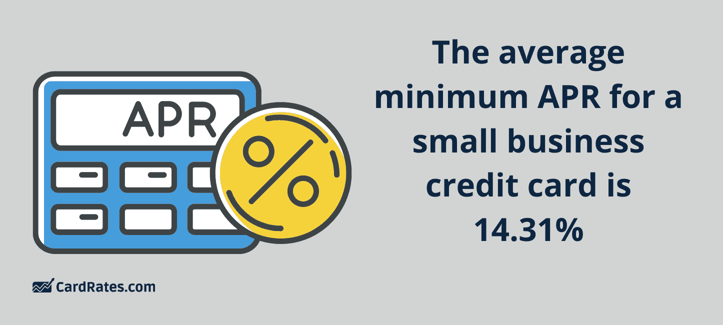
32. The average minimum APR for a small business credit card is 14.31%. The average maximum APR is 21.34%.9
33. A 2023 survey reported that, after office supplies (78%), the most popular card expense categories included operating expenses (70%), travel (65%), inventory (55%), meals (49%), and raw materials (37%).4
34. A minority of entrepreneurs (31.1%) used a card they applied for and received to operate their business in 2022. A higher percentage (38.3%) saw their applications rejected.1
35. Out of a sample of 50 cards, a total of 25 small business cards offered cardholders points and miles rewards. A total of 18 offered cash back rewards, and four cards offered a choice.9
36. In a sample of 50 small business cards, slightly more than half had no annual fee. That means most small businesses can find a fee-free card.9
37. Only about 20% of small business owners reported holding a business credit card in a 2022 survey, but about 50% reported using it weekly.12
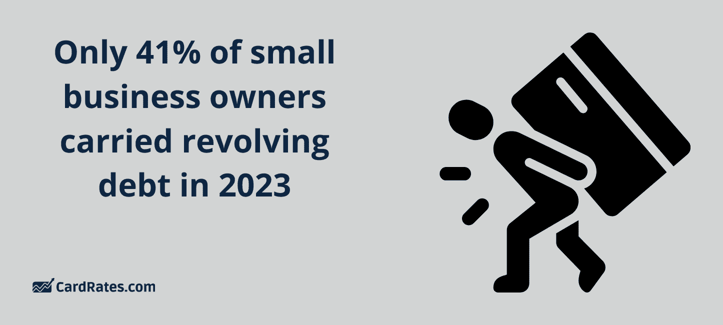
38. A 2023 report on small business financial well-being indicated that 38% of small businesses reported being better off than in 2022, with only 41% carrying revolving debt (down from 44% in 2022).4
39. Quick access to funds motivated 22.8% of respondents in a 2023 survey to use business credit cards as their primary funding method.1
40. Business and personal credit card ownership disparities occur along racial lines. In 2022, almost one-third (31%) of African American small business owners reported lacking a personal and business credit card compared to white owners (12%).12
41. Among entrepreneurs operating a new business in 2022, 14.7% used an existing personal credit card, 7.6% used an existing business credit card, and 3.7% didn’t use a credit card.1
42. Entrepreneurs who spend more on business cards are likelier to use rewards and other supplementary card benefits.4
43. About one-third of a sample of 50 small business credit cards came with a 0% introductory APR offer on purchases. Fewer than 10% provided a 0% APR on balance transfers.9
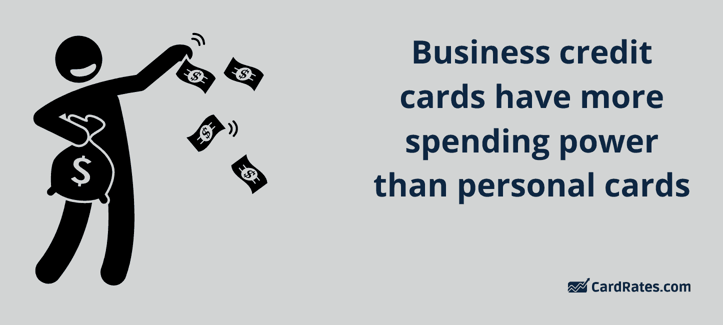
44. Business credit cards have more spending power than personal cards. Only 30% of respondents in a 2022 survey reported a business credit limit of less than $5,000.12
45. More than half (54.2%) of respondents in a 2023 survey reported they consistently paid their monthly balances in full after using their cards as their primary business financing method.1
46. Small businesses spent an average of $13,000 a month on their credit cards in 2023.4
47. Common uses for personal credit cards among small business owners responding to a 2022 survey were meeting day-to-day operating expenses (63%), expanding the business and pursuing new opportunities (50%), and replacing or repairing large, long-lasting business assets (38%).12
48. In 2023 survey data, most new businesses applying for business cards (88.61%) reported having at least three cards. Among those who used cards to initiate their businesses, 34.3% had three new cards, 45.71% had four cards, and 8.6% had at least five.1

49. The average signup bonus on a small business credit card is $398. The average points-and-miles bonus is 68,000 points.9
50. Some types of businesses are more likely to carry a revolving credit line than others. Repair and maintenance businesses are most likely (38%), while healthcare services businesses are least likely (27%).2
51. Most business credit cards do not cap the amount of rewards holders can earn. Only eight of 47 in a 2021 survey placed a cap on rewards earning.9
In Conclusion
Business credit cards perform the same function for entrepreneurs as personal cards do for families, providing businesses with additional liquidity to make purchases on a convenient timeline.
Enough competition exists to provide options for businesses of various sizes, from the smallest to the largest.
This collection of business credit card statistics provides readers with an authoritative description of the current marketplace and emerging industry trends.
Data Sources:
1 https://www.forbes.com/advisor/credit-cards/business-credit-card-statistics/
2 https://www.jpmorganchase.com/institute/research/small-business/small-business-use-of-credit-cards
3 https://www.statista.com/statistics/936159/leading-small-business-credit-cards-usa-by-purchase-volume/
4 https://www.jdpower.com/business/press-releases/2023-us-small-business-credit-card-satisfaction-study
5 https://www.foxbusiness.com/economy/small-businesses-are-driving-credit-card-debt-higher
6 https://www.creditcards.com/statistics/business-credit-card-statistics/
7 https://www.cpapracticeadvisor.com/2023/10/11/small-business-credit-card-spending-up-20-percent-post-pandemic/95755/
8 https://www.docuclipper.com/blog/credit-card-debt-statistics/
9 https://www.lendingtree.com/credit-cards/study/small-business-credit-card-report-2021/
10 https://www.paymentsdive.com/news/small-business-credit-card-delinquency-ach/700155/
11 https://www.pymnts.com/smbs/2023/business-credit-card-use-hits-year-high-smbs-manage-cash-flow/
12 https://helloalice.com/small-business-credit-stats-2022/


![[current_year] Credit Card Debt Statistics (Average U.S. Debt) [current_year] Credit Card Debt Statistics (Average U.S. Debt)](https://www.cardrates.com/images/uploads/2018/04/shutterstock_243114739-edit.jpg?width=158&height=120&fit=crop)
![15 Disturbing Credit Card Fraud Statistics ([current_year]) 15 Disturbing Credit Card Fraud Statistics ([current_year])](https://www.cardrates.com/images/uploads/2020/08/shutterstock_576998230.jpg?width=158&height=120&fit=crop)
![21 Startling Credit Card Data Breach Statistics ([current_year]) 21 Startling Credit Card Data Breach Statistics ([current_year])](https://www.cardrates.com/images/uploads/2023/10/Credit-Card-Data-Breach-Statistics.jpg?width=158&height=120&fit=crop)
![11 Surprising Teen Credit Card Statistics ([current_year]) 11 Surprising Teen Credit Card Statistics ([current_year])](https://www.cardrates.com/images/uploads/2023/10/Teen-Credit-Card-Statistics.jpg?width=158&height=120&fit=crop)
![18 Revealing Credit Card Ownership Statistics ([current_year]) 18 Revealing Credit Card Ownership Statistics ([current_year])](https://www.cardrates.com/images/uploads/2023/11/Revealing-Credit-Card-Ownership-Statistics.jpg?width=158&height=120&fit=crop)
![25 Shocking Credit Card Processing Statistics ([current_year]) 25 Shocking Credit Card Processing Statistics ([current_year])](https://www.cardrates.com/images/uploads/2023/11/Credit-Card-Processing-Statistics.jpg?width=158&height=120&fit=crop)
![25 Fascinating Credit Card vs. Cash Spending Statistics ([current_year]) 25 Fascinating Credit Card vs. Cash Spending Statistics ([current_year])](https://www.cardrates.com/images/uploads/2023/11/Fascinating-Credit-Card-vs.-Cash-Spending-Statistics.jpg?width=158&height=120&fit=crop)
![21 Eye-Opening Student Debt Statistics ([current_year]) 21 Eye-Opening Student Debt Statistics ([current_year])](https://www.cardrates.com/images/uploads/2020/11/shutterstock_674141887.jpg?width=158&height=120&fit=crop)